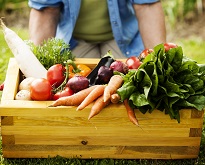With 12 million hectares of certified area or area under conversion in 2016, organic farming made up 6.7% of the European Union's (EU) total utilised agricultural area (UAA). Since 2012, the area devoted to organic farming has grown by almost two million hectares. Similarly, an upward trend can be observed in the number of registered organic producers, which reached 295 600 at the end of 2016.
Among Member States, Spain, Italy, France and Germany registered the largest organic areas as well as the largest numbers of organic producers in 2016. Together they account for over half (54%) of both total EU organic crop area and organic producers in the EU.
Organic farming combines best environmental practices, a high level of biodiversity, the preservation of natural resources and high production standards based on natural substances and processes. It provides for a specific market responding to a specific consumer demand while at the same time delivering public goods in terms of environmental protection, animal welfare and rural development.
Austria, Sweden and Estonia on top for organic farming
The part of agricultural land farmed organically differs widely between EU Member States. The highest share of crop area dedicated to organic farming was registered in Austria, where over one fifth (21%, or 571 thousand hectares) of total agricultural area was farmed organically in 2016. It was followed by Sweden (18%, or 553 thousand hectares) and Estonia (18%, or 181 thousand hectares). Alongside these top performers, Italy (14%, or 1 796 thousand hectares), the Czech Republic (14%, or 489 thousand hectares), Latvia (13%, or 259 thousand hectares) and Finland (10%, or 238 thousand hectares) also reported over 10% of agricultural land farmed organically.
In contrast, organic farming was not strongly developed in nine Member States, where the area under organic farming was below 4% of agricultural land: Malta (0.2%, or 24 hectares), Romania (1.7%, or 226 thousand hectares), Ireland (1.7%, or 77 thousand hectares), followed by the United Kingdom (2.8%, or 490 thousand hectares), the Netherlands (2.9%, or 52 thousand hectares), Bulgaria (3.2%, or 161 thousand hectares), Luxembourg (3.3%, or 4 300 hectares), Hungary (3.5%, or 186 thousand hectares) and Poland (3.7%, or 537 thousand hectares).
It should be noted that the importance of the organic sector is generally lower in regions with plains, where more intensive production systems prevail.
The source dataset can be found here.
This news item, which shows only a small selection of the wide range of data on organic farming available at Eurostat, is complemented with a Statistics Explained article.


